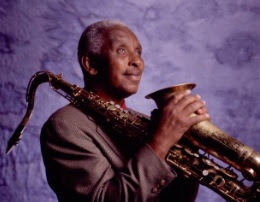Theodore Marcus Edwards (April 26, 1924 – April 20, 2003) was an American jazz tenor saxophonist.
Theodore Marcus "Teddy" Edwards was born in Jackson, Mississippi to a musical family. His grandfather, Henry C. Reed, played the bass and his father, Bruce Edwards, trombone, violin and reed instruments. Under these circumstances it was quite obvious that Teddy started to play very young, at first alto saxophone and later clarinet.
His uncle sent for him to come to Detroit to live because he felt opportunities were better. Due to illness in the family, he went back to Jackson and ventured to Alexandria, Louisiana. He was persuaded by Ernie Fields to join his band after going to Tampa, Florida. Edwards had planned to go to New York City, but Fields convinced him he could get there by way of Washington, D.C., if he worked with his band. Edwards ended up at the "Club Alabam" on Central Avenue in Los Angeles, which later became his city of residence.
After leaving the West Coast with Ernie’s Orchestra he came back in February, 1945 to join Roy Milton’s Rhythm and Blues Band. Howard McGhee, during that time, was working with the Coleman Hawkins Quintet at Billy Berg’s Cocktail Lounge and stayed in Los Angeles after finishing that engagement to form his own group. Unable to find a tenor player with the harmonic knowledge and the approach that he needed, he suggested Teddy switch to the tenor. Teddy eagerly agreed because Howard’s music was more in the idiom that he was interested in playing. So he joined with Howard with Roy Milton’s good blessings.
Edwards played with many jazz musicians, including his personal friend Charlie Parker, Roy Milton, Wynonie Harris, Vince Guaraldi, Joe Castro and Ernie Andrews. A 1947 recording with Dexter Gordon, The Duel, was an early challenge to another saxophonist an approach he maintained whenever possible, including a recording with Houston Person. One such duel took place in the 1980s at London's 100 Club with British tenor Dick Morrissey.
Around July, 1954 Teddy had a phone call from Max Roach inviting him to come to Los Angeles to finish out his Clifford Brown’s engagement at the “Californian Club” in Los Angeles, because Sonny Stitt had to leave to fulfill previous commitments. That’s where he recorded his most famous composition “Sunset Eyes” which he wrote in 1948. This group’s first recording date also consisted of Carl Perkins piano and George Bledsoe on bass.
From 1948 until he recorded in 1958 with Leroy Vinnegar on his first album “Leroy Walks”, the Max Roach –Clifford Brown recording was the only jazz record he made in 1954. During this period the so-called West Coast jazz thing came into existence and Teddy was completely excluded, although he felt some of these were his best playing years. In 1959 he played in Earl Bostic’s band and made in 1960 a thirty minute television (biographical film for Steve Allen’s “Jazz Scene U.S.A” (composed and arranged the music for this film shown in 42 countries).
During the early sixties the California recording scene began to change and he recorded his first album with the Les McCann trio “It’s About Time,” and also his “Sunset Eyes” album. Shortly thereafter he signed a contract with Contemporary Records. Gerald Wilson formed another orchestra to record for Pacific Jazz. Teddy and Harold Land were the featured soloists with the band along with trumpeter Carmel Jones and others. The band played the 1963 Monterey Festival.
In 1964 he was hired by Benny Goodman to play at Disneyland with his band. After going East, Benny Goodman sent for Teddy Edwards to join his sextet, which included cornet player Bobby Hackett, pianist Vince Guaraldi and singer Marilyn Monroe. Teddy stayed in New York to play and write for the big band that Benny Goodman formed to play the 1964 World’s Fair. After a while he went back to Los Angeles and worked several jobs including the Red Skelton TV show with the Dave Rose orchestra.
In 1965, he was in Monterey again with Dizzy Gillespie – Gil Fuller big band and Earl “Father” Hines group. Then an association with Ernie Garside, his British tour manager, led to regular tours, which extended across Europe. His recordings burgeoned - including collaborations with Tom Waits - as did arranging assignments and concert engagements with his innovative brass-string ensemble.
Edwards was diagnosed with prostate cancer in 1994, but he kept the illness quiet, determined to fight back and continue with his career. At first, when it seemed he would recover, he came back to even greater popularity. By April of 2001, the cancer began to overtake him and seriously affect his playing. A Teddy Edwards Celebration in Los Angeles was supposed to feature Edwards and his Brass String Ensemble.
Sadly, Edwards was unable to play because chemotherapy treatments caused muscle spasms in his arms. His final nursing costs were funded by Herb Alpert, an old friend. He died in Los Angeles on April 20, 2003 at the age of 78.
(Edited from Wikipedia. Obit by Peter & Greetje Juijts & The Guardian)









